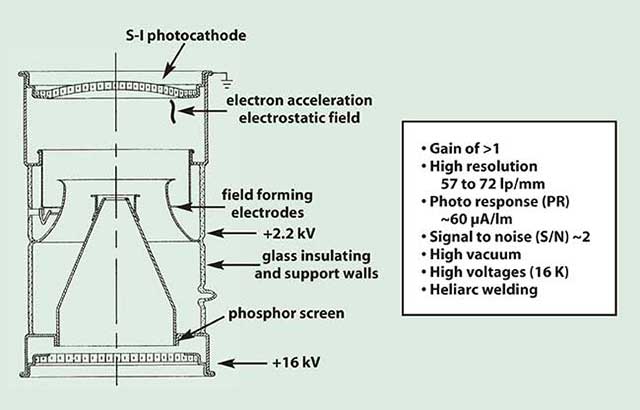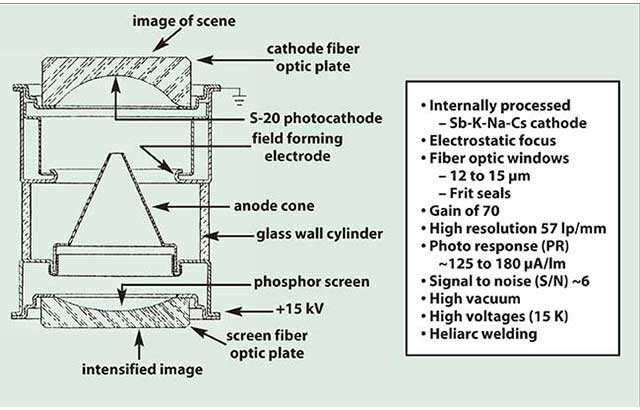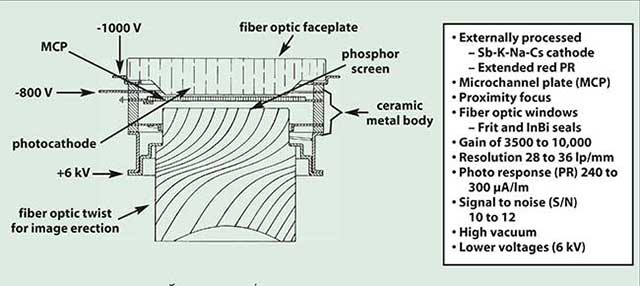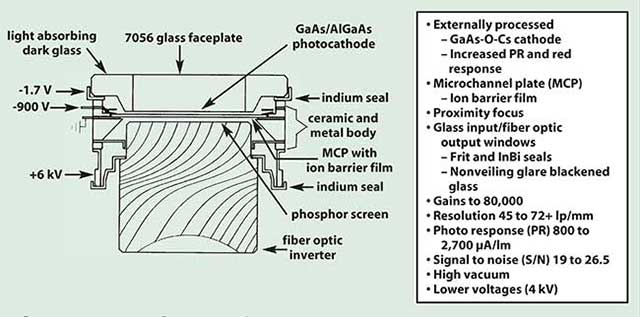Development of Image Intensifier Tubes
2022-08-08
Contact Engineer manager
Engineer Manager Name: Jacky
WhatsApp/ Wechat: 0086-18792456795
Email: mh_elec@126.com or jacky@mh-elec.com
Image intensifying devices have brought vision into the dark of night through generations.
An image intensifier tube is a vacuum tube device used to increase the intensity of light available in an optical system for use in low-light conditions, such as at night, to facilitate visual imaging of low-light processes; Such as fluorescent materials in X-rays or gamma rays (X-ray image intensifiers); Or for converting non-visible light sources, such as near-infrared or shortwave infrared, to visible light. They work by converting photons of light into electrons, amplifying the electrons (usually with microchannel plates), and then converting the amplified electrons back into photons for viewing. Image intensifier tubes are widely used in devices such as night-vision goggles.
What Does The Generation Gap Mean?
The term "generation (Gen)" refers to a major advance in image enhancement technology for night vision devices, with a higher "Gen" indicating more advanced night vision technology. "Gen" is not only a change in technology, but also a change in nomenclature like booster tubes.
Gen0 Image Intensifier Tube
During World War II and the Korean War, the development of stealth warfare and formal sniper training as part of military exercises led to the development of image enhancement.
The image converters (aka: sniper scopes) used by early snipers required infrared light sources to assist in illuminating the target, and these image converters were referred to as Gen0. Gen0 picture converters evolved from picture converter tubes developed by RCA in the mid-1930s for televisions.
The Gen 0 image converter uses an S-1 photocathode, an infrared sensor with a high-voltage electron-accelerating electrostatic field, and a phosphor screen. The previous S-1 cathodes (AgOCs) used less cathode quantum efficiency than today, but were able to provide images with the help of an infrared light source.

Gen0 Image Intensifier Tube
The working principle of Gen0 image intensifier tubes is very simple. After the reflected infrared light source enters the tube, the light is converted into electrons through the photocathode electrode. A cone-shaped assembly (the anode) focuses these electrons and uses an ultra-high voltage to speed up and increase the energy hitting the phosphor screen to reconstruct a visible image. But electrons accelerated in this way don't produce much gain, but are prone to image distortion and short lifespan of the tube.
Gen1 Image Intensifier Tube
Starlight sights developed in the early 1960s used the Gen1 image intensifier, which had three image intensifier tubes connected in series, making the night vision larger and heavier. The starlight sight uses the method of multiple tubes in series to obtain a larger overall light gain, but because the power design of the sight is too simple, the overload of the image tube caused by the strong light source leads to the easy occurrence of instantaneous image washout.

Gen1 Image Intensifier Tube
The main difference between Gen1 and Gen0 image intensifier tubes is that the chemistry of the photocathode is more complex for Gen1 image tubes. The S-20 cathode uses a polybasic antimonide process to improve sensitivity and spectral response. However, Gen1 and Gen0 image intensifier tubes share the same disadvantages, such as image distortion and short lifespan. Today, night vision devices no longer use Gen0 and Gen1 image intensifier tubes.
Gen2 Image Intensifier Tube
With the development of microchannel plates, the Gen2 image intensifier tubes developed in the late 1960s brought a major breakthrough in night vision technology. In addition, the photocathode technology used in Gen1 was further upgraded to an S-25 cathode and produced a larger photoresponse.

Gen2 Image Intensifier Tube
And, with the introduction of MCP, Gen2 image intensifier tube is unique. MCP starts with two different pieces of glass, a large tube of solid glass (core) placed inside a glass tubular casing (cladding). The two glasses are then heated and stretched together to form very small diameter glass fibers that are eventually compressed together to form a bundle of glass fibers that becomes a blank. The ingot is then angled to obtain thin wafers, which are then chemically processed to remove the core glass to form channels within the MCP. During operation of the tube, secondary electron emission occurs as electrons enter the channel and mount to the channel walls, producing hundreds of electrons.
Gen3 Image Intensifier Tube
Gen3 image intensifier tubes were developed and put into production in the 1970s-1980s, but the overall appearance of Gen2 and Gen3 tubes is very similar. The difference is that the Gen3 image intensifier tube uses gallium arsenide (GaAs) as the photocathode, which results in a significant increase in the sensitivity of the tube, especially in the near-infrared region, which improves system performance in low-light conditions. In other words, the upgrade allows the tube to detect light at greater distances.

Gen3 Image Intensifier Tube
However, the highly reactive GaAs photocathode is easily degraded by the inherent chemistry that occurs within the tube under normal operation. This is because the interaction of electrons with the MCP channel walls allows most chemical reactions to take place within the MCP. Therefore, to overcome the degradation effect of the photocathode, a thin metal oxide coating is usually added on the input side of the MCP. This coating, commonly referred to as an ion-barrier film, not only prevents premature degradation of the photocathode, but also increases the lifetime many times that of Gen2 tubes.
Over the years, manufacturers of Ge2 and Gen3 tubes have continued to optimize and upgrade to improve the signal-to-noise ratio of each tube technology produced. In addition, continuous improvements have been made in MCP manufacturing to increase overall resolution, and Gen2 and Gen3 tubes are commonly used in night vision products on the market today.
Summary
Today, Gen0 and Gen1 image intensifier tubes have disappeared from the night vision market, while Gen2 and Gen3 image intensifier tubes are commonly used in night vision equipment. However, compared with the Gen2 image intensifier tube, the Gen3 image intensifier tube has higher image clarity and longer service life, but the price is also higher than the Gen2 image intensifier tube. Therefore, when choosing a night vision product, you need to choose a more suitable product according to your budget and needs.
Contact Engineer manager
Engineer Manager Name: Jacky
WhatsApp/ Wechat: 0086-18792456795
Email: mh_elec@126.com or jacky@mh-elec.com
 tel
tel



